
Richmond, Virginia
aFib, Heart Failure, Hypertension, Provider Group, RPM and CCM
Virginia Cardiovascular Specialists
HealthSnap’s platform and staff are excellent. We interviewed multiple providers and our team felt that HealthSnap had the best program and model to support us in launching successful and impactful RPM and CCM programs for our patients.
Summary
Virginia Cardiovascular Specialists (VCS) is the largest, private cardiology practice in central Virginia. VCS physicians have a reputation for being the best, most respected, cardiologists in the state with 37 board-certified cardiologists in eight offices conveniently located around Richmond. VCS physicians are affiliated with either HCA Virginia or Bon Secours facilities in the Richmond area. Physicians of VCS are board-certified and Fellows of the American College of Cardiology. Many also have additional sub-specialty training in cardiovascular intervention, carotid stenting, CT angiography, electrophysiology, and peripheral vascular disease.
Challenge
Ann Honeycutt, MN, executive director of VCS, shared that the practice has been using Chronic Care Management (CCM) as a service for its patients for over five years, and the team at VCS already recognized the clinical importance when deciding to add RPM as a complementary program. VCS is actively involved in an Accountable Care Organization (ACO), so managing patients’ high-risk outcomes is top of mind as a critical measure of success.
When VCS was adding Remote Patient Monitoring (RPM) with HealthSnap as a new offering, the team felt it would be important to partner with one company for both RPM and CCM in order to have a unified experience for patients, with one nurse managing both programs. She explained, “working with HealthSnap for both RPM and CCM programs is excellent for patient experience and continuity, and it also streamlines communication with the physicians.”
Program Highlights
At the onset of HealthSnap and VCS’ RPM partnership, Dean Caven, President of VCS stated, “HealthSnap’s leading Remote Patient Monitoring capabilities will enable our physicians to be more proactive in the care they provide, and their chronic disease-agnostic Remote Patient Monitoring will be an important part of our overall virtual care strategy.”
Months into utilizing the platform, VCS has noted a 5-star rating for its experience working with HealthSnap. Ann shared, “the HealthSnap team was extremely engaged and dedicated to getting our launch off the ground. HealthSnap ensured that our patients were getting the support needed to be a part of the program.”
She also noted that the communication tools and portal are both efficient and easy to use:
“HealthSnap tools and staff are excellent. We interviewed multiple providers and our team felt that HealthSnap had the best program and model to support us in launching successful RPM and CCM programs.”
Clinical Results
For the most reliable analysis, we used the average of the first seven data transmissions and compared them to the average of the last seven data transmissions to account for learning effects and daily variation.
The study encompassed a cohort of 6,356 patients who satisfied the inclusion criteria, defined as a minimum of 90 days of participation in the program and a data transmission index of at least 30%. Within this population, 4,178 patients (65.7%) were identified with uncontrolled hypertension (≥ 130 or ≥ 80) at the time of enrollment. Following an average engagement duration of 390 ± 219 days in the program, a significant proportion, 32.3% (n=1,350), exhibited improvement in controlled blood pressure levels (≤ 130 and ≤ 80), a result that was determined to be statistically significant (p < 0.0001; McNemar test).
Furthermore, among the initial cohort, 2,355 patients (37.0%) were diagnosed with Stage 2 hypertension (≥ 140 or ≥ 90) at the point of entry into the program. Of these, 58.2% (n=1,371) achieved a reduction to below Stage 2 hypertension levels (≤ 140 and ≤ 90)after an average participation period of 393 ± 219 days, with this outcome also reaching statistical significance (p < 0.0001; McNemar test). These findings underscore the e cacy of the program in facilitating meaningful improvements in blood pressure control among patients with varying degrees of hypertension.
Patient Engagement & RPM Data Transmission
The Centers for Medicare & Medicaid Services (CMS) recommendations emphasize the importance of frequent patient data transmission for improved clinical outcomes, as the requirement for billing code 99454, which requires at least 16 days of patient readings within a 30-day period.
HealthSnap’s internal analysis focusing on a cohort of 17,558 patients with uncontrolled hypertension revealed that those transmitting data over two-thirds of the time showed statistically significant improvements in physiological variables (p < 0.0001). VCS exceeded these benchmarks, achieving an average patient transmission index of 69.1% ± 19%, illustrating the effectiveness of RPM and CCM in improving patient engagement and healthcare outcomes.
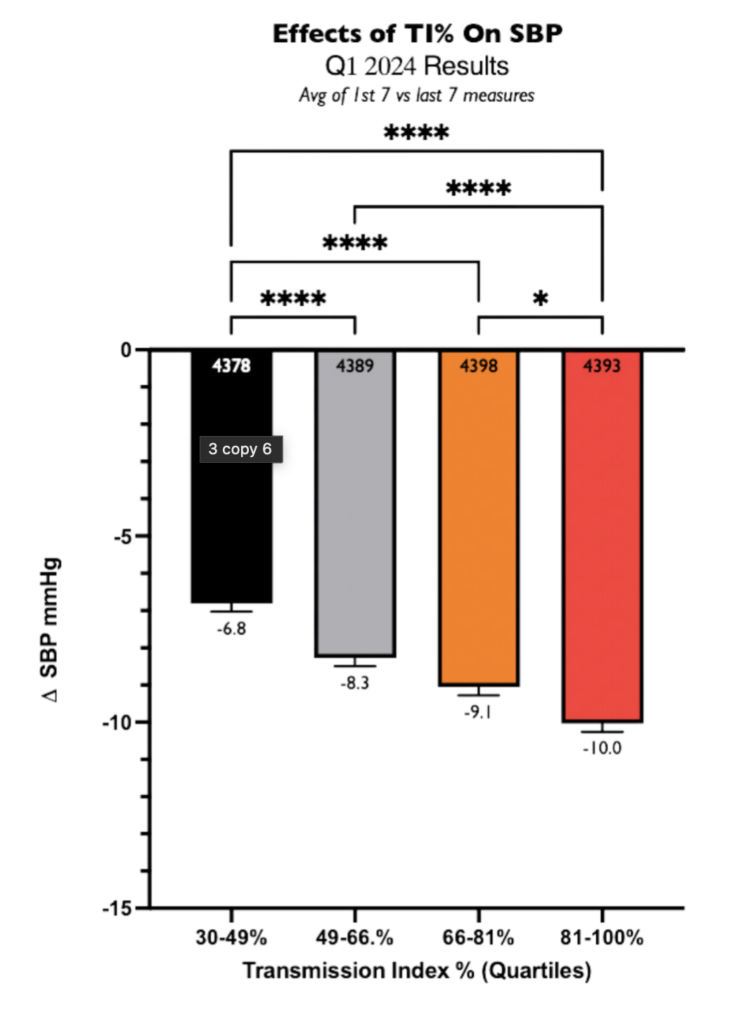
Additionally, VCS exhibited a higher transmission index (69%) compared to that observed in other client specialties, such as Primary Care (64%), Nephrology (68%), Cardiology (67%), and Other Multi-Disciplinary Enterprises (61%). This higher rate of data transmission at VCS likely contributed to more significant improvements in mean arterial pressure (MAP), with VCS achieving a reduction of – 6.9 mmHg. This improvement surpasses the reductions recorded across the aforementioned specialties: Primary Care (- 5.7 mmHg), Cardiology (- 6.1 mmHg), Nephrology (- 6.0 mmHg), and Other Multi-Disciplinary Enterprises (-6.2 mmHg).
Uncontrolled Hypertension
Among the 4,178 patients with baseline uncontrolled hypertension (HTN), significant reductions were observed after an average of 390 ± 219 days on the program. SBP decreased by 9.5 mmHg from an initial average of 143.5 mmHg to 134 mmHg. DBP was reduced by 5.5 mmHg from 82.2 mmHg to 76.6 mmHg, and pulse pressure decreased by 3.9 mmHg from 61.3 mmHg to 57.4 mmHg. All changes were highly statistically significant (p < 0.0001).
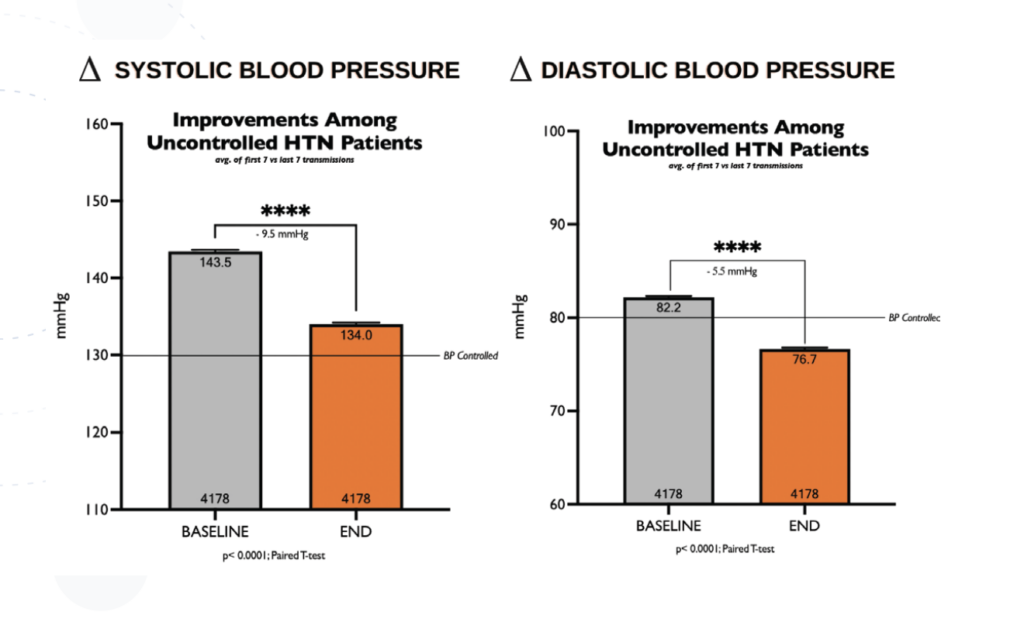
Among these 4,178 patients dealing with uncontrolled HTN, 67% (2,771) achieved a reduction in SBP, and an equal proportion of 67% (2,768) experienced a decrease in DBP. Notably, 32.3% of these patients improved to controlled blood pressure levels, defined as SBP < 130 mmHg and DBP < 80 mmHg.
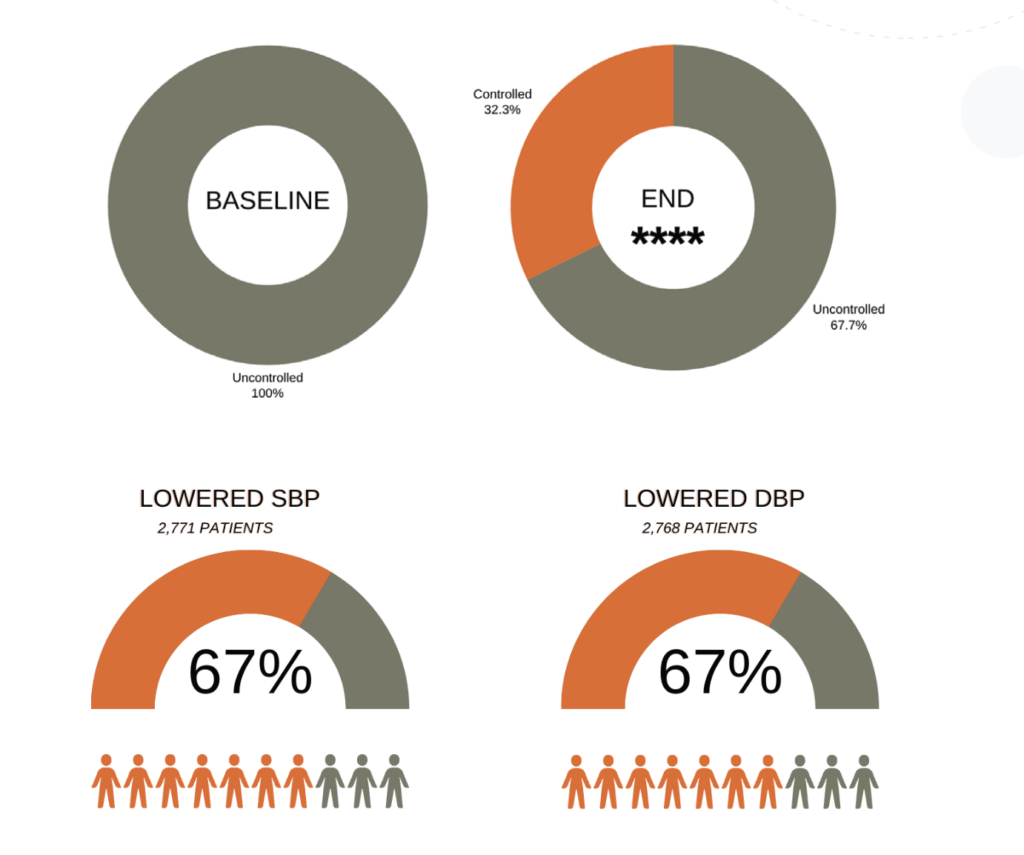
Stage 2 Hypertension
In the subset of 2,355 patients with initial stage 2 HTN, participation in the program for an average duration of 393 ± 219 days resulted in notable blood pressure reductions. SBP experienced a decrease of 14.4 mmHg, moving from an average of 151.7 mmHg to 137.3 mmHg. DBP declined by 7.9 mmHg, from 85.1 mmHg to 77.2 mmHg, while pulse pressure was reduced by 6.5 mmHg, from 66.6 mmHg to 60.1 mmHg. These improvements were statistically significant (p < 0.0001).
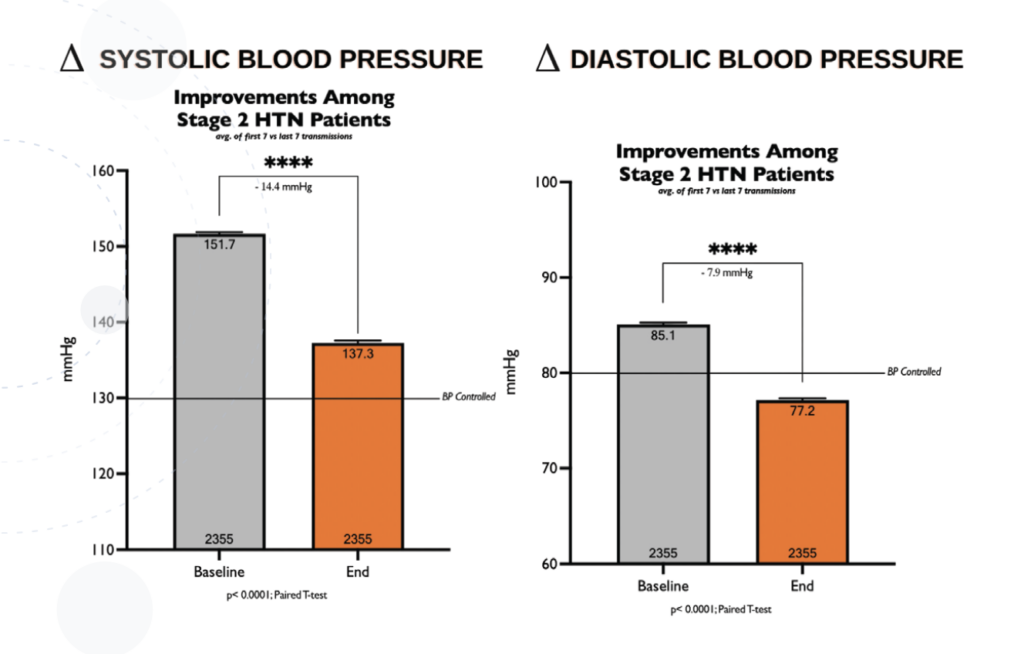
Among the 2,355 individuals with Stage 2 HTN, significant blood pressure improvements were observed: 74% (1,741) of the patients experienced a reduction in SBP, and 73% (1,711) saw a decrease in DBP. Furthermore, 58.2% of the participants achieved blood pressure levels below the threshold for Stage 2 HTN, specifically SBP < 140 mmHg

Program Duration & Mean Arterial Pressure
To evaluate the impact of program duration on clinical outcomes within remote hypertension management, improvements in Mean Arterial Pressure (MAP) were analyzed across duration quartiles among patients with uncontrolled hypertension from VCS. The first quartile (Q1), spanning 90-230 days, observed a MAP reduction of 5.7 mmHg. The second quartile (Q2), covering 231-340 days, saw a decrease of 5.2 mmHg in MAP. The third quartile (Q3), ranging from 341-473 days, achieved a 6.8 mmHg reduction. Notably, the fourth quartile (Q4), which included durations from 474 to 875 days, experienced the most significant improvement with a 7.8 mmHg reduction in MAP.
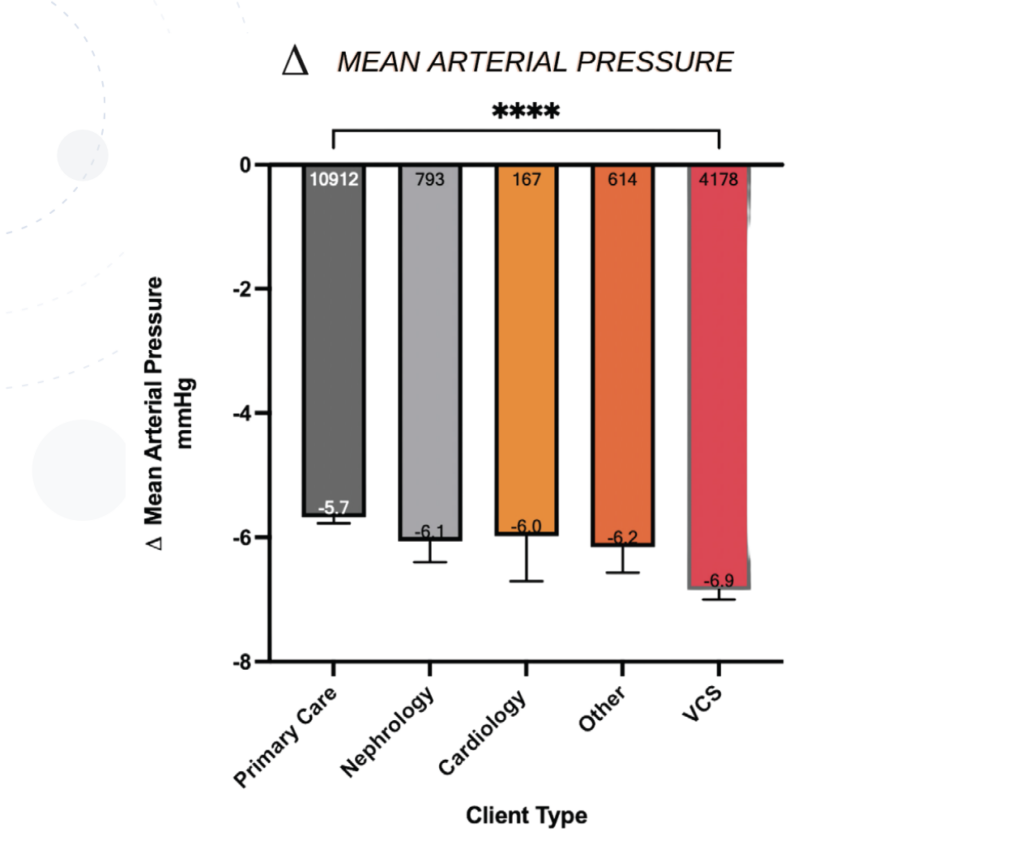
Conclusion
This analysis underscores the successful execution of the RPM and CCM program by VCS, which has proven highly effective in managing hypertension and enhancing patient outcomes. We express our utmost appreciation for this collaboration and eagerly anticipate our continued work together as we strive to transform cardiology care and increase our patient impact.







